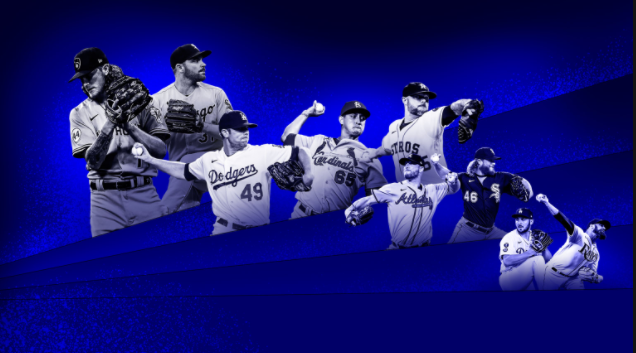Is It Worth It To Pay Big Money to Relief Pitchers?
Pictured are some of the best Relief pitchers in baseball, Including Josh Hader, Liam Hendriks, Blake Treinen, Giovani Gallegos, Ryan Pressly, Will Smith, Craig Kimbrel, and Phil Bickford.
January 11, 2022
Relievers. Some come into the game for 1-2 inning spurts; others come in to take over most of a game for a starter. Since there usually are 1-2 days in between each appearance, they have opportunities to perfect their signature pitches (ex: Mariano Rivera’s cutter, Eric Gagne’s fastball, Josh Hader’s slider). But are they worth the big money that guys like Corey Seager, Marcus Siemen, and Max Scherzer are getting?
Firstly, we must identify the role of the bullpen in the pitching aspect of baseball. The bullpen is used to relieve the starting pitcher if their pitch count is high, they are getting batted around, they have run out of gas, and so many other reasons. The objectively best bullpen is the one the Braves had in the 2021 postseason. they relied on the starter lasting 5-6 strong innings before handing it over to the bullpen (nicknamed The Nightshift) which consisted of Tyler Matzek or A.J Minter in the 7th, Luke Jackson in the 8th, and Closer Will Smith to shut the door in the 9th. With the staff that they have this model for a bullpen works. But teams with a struggling/not great pitching staff (I.e., the Orioles, Rangers, Pirates, Mariners) would have to use several long relief pieces, meaning guys who usually are excess starting pieces or starters that are not good enough to make the rotation (I.e., Tanner Houck and Garret Richards of the Red Sox) since their staff is not built to go 5+ innings.
Next, we will identify the constancy of some of these arms. On the one hand, we have guys like Mark Melancon, Liam Hendriks, and Kenly Jansen, who all had 38+ Saves in 43+ attempts being consistent in their appearances to close out games. You also have guys like Aroldis Chapman, Matt Barnes, and Craig Kimbrel, who all had above average, to great first four months of the season but struggled in the second half all for their different reasons. (Kimbrel because of when he was being used, Barnes because of how predictable his pitches have become using a Fastball and Curveball, And Chapman because of substances). Then you have consistently average guys, like Gregory Soto, Emmanuel Clase, and Adam Ottavino.
Five players come to mind as all-time greats in a more historical aspect: Mariano Rivera, Eric Gagne, Dennis Eckersley, Rich “Goose” Gossage, and Trevor Hoffman. They are all great because they have their own pitch that is difficult to duplicate, making it hard to counter. Rivera because of his Cutter, Gagne because of his fastball, Eckersley because of his cut fastball, Gossage because of his delivery and how fast he throws, and Hoffman because of his changeup. I mention this because these are so incredibly rare to find. He was arguably the best reliever of the last few seasons. Liam Hendriks grinded in the minor leagues for a decade before he made it up with the Athletics. Another great reliever was Kenly Jansen, who grinded in the minors for six years before making it to the major leagues with the Dodgers.
Now picture this… you are the general manager of the New York Mets. You have lost your key closer, Edwin Diaz, in free agency to the rival Atlanta Braves, and you have three guys on the table. Those men are Craig Kimbrel, Will Smith, And Matt Barnes. You have an overall solid bullpen with Aaron Loup and Trevor May covering the 7th and 8th inning. What are your offers to all three guys? Knowing that any of those three can fall off a cliff skill-wise, you should be cautious, knowing their potential and how they may want more money with more years if they do well.
In conclusion, unless the guy you are attempting to sign can be consistent and perform at a high level, you should not be paying relief and Closing Pitchers’ money that more Position Players and Starting Pitchers receive.


